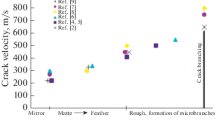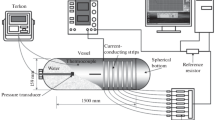Abstract
The loading and unloading of a Plexiglas plate by a running fracture is investigated by means of a series of high-frequency cinematographic pictures of the shadows originating around drilled holes. Near the fracture tip, -the stress distribution differs only slightly from that around a corresponding static crack. After the fracture tip, however, there are great deviations owing to the dynamic unloading of the plate. The velocity of the unloading process is considerably lower than the velocity of the transversal waves in the plate.
Résumé
Les modifications de lacharge dans une plaque de Plexiglas sous 1' effet d' une fissure en cours de propagation ont été étudiées par diffraction de la lumière.
La technique consiste à filmer, à grande vitesse, les ombres projetées sur une plaque de réféerence par des trous forés dans la plaque; la position et les dimensions de ces ombres donnent une repréesentation quantitative de 1'état de tension règnant autour de chaque trou
On a pu, ainsi, montrer que la distribution des tensions, au voisinage du front de fissure, ne differe que légèrement de celui règnant au voisinage d' une fissure statique. Par contre, de grandes déviations de l'état de tension ont été observées en arrière du font de fissure, en raison d' un déchargement dynamique de la plaque. La vitesse à laquelle se produit ce processus de déchargement est considérablement plus faible que la vitesse des ondes transversales dans le matériau considéré.
Zusammenfassung
Mit Hilfe einer schattenoptischen Anbohrmethode wird der Be- und Entlastungsvorgang dutch einen laufenden Bruch in einer Plexiglasplatte anhand hochfrequenzkinematografischer Bildserien untersucht. In der Nähe der Bruchspitze erweist sich der Unterschied der Spannungsverteilung zu derjenigen um einen entsprechenden statischen Riß als gering. Hinter der Bruchpitze ergeben sich durch die dynamische Entlastung der Platte dagegen große Abweichungen. Die Geschwindigkeit des Entlastungsvorgangs is t wesentlich geringer als die Geschwindigkeit der Transversalwellen in der Platte.
Similar content being viewed by others
References
H. Schardin Z. Kunststoffe, 44, 2, 48–55 (1954).
F. KerkhofKunststoffe, K. A. Wolf (ed. ), Springer-Verlag, Berlin, 440–484 (1958).
G. R. Irwin Handbuch der Physik, VI, S. Flugge (ed.), Springer-Verlag, Berlin, 551–590 (1958).
H. Henschen Dissertation, Freiburg i Br. (1962).
A.A. Wells and D. PostProc.Soc. of Exp. Stress Anal., 16. 69–92 (1958).
I.N. Sneddon Proc.Phys.Soc. (London), 187, 229–260 (1946).
P. ManoggDissertation, Freiburg i. Br. (1964).
P. ManoggGlastechnische Berichte, 39, 323–329 (1966).
A. Stanzel Ktuzzeitphotographie, IV Int. Congress, Cologne, Helwich-Verlag, Darmstadt (1958).
P. Manogg Phys. of Non-Crystalline Solids, Intl. Conf. Delft, North-Holland Publ. Co., Amsterdam (1964).
Author information
Authors and Affiliations
Rights and permissions
About this article
Cite this article
Manogg, P. Investigation of the rupture of a plexiglas plate by means of an optical method involving high-speed filming of the shadows originating around holes drilled in the plate. Int J Fract 2, 604–613 (1966). https://doi.org/10.1007/BF00184557
Received:
Issue Date:
DOI: https://doi.org/10.1007/BF00184557




